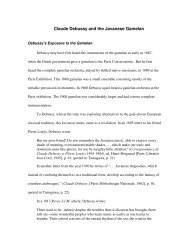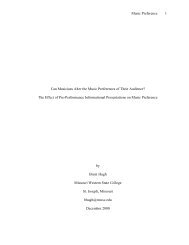Claude Debussy and the Javanese Gamelan
Claude Debussy and the Javanese Gamelan
Claude Debussy and the Javanese Gamelan
Create successful ePaper yourself
Turn your PDF publications into a flip-book with our unique Google optimized e-Paper software.
House Lights<br />
UP<br />
H<strong>and</strong>out<br />
Summary of<br />
gamelan influences<br />
on each piece<br />
Figure: “Pagodes”<br />
• This <strong>the</strong>me uses a different pentatonic scale.<br />
• [Play G#-B-C#-D#-F]<br />
Brent Hugh, Page 14<br />
• In all, <strong>Debussy</strong> uses five or six different versions of <strong>the</strong> pentatonic scale in<br />
“Pagodas.”<br />
• To fur<strong>the</strong>r evoke <strong>the</strong> feeling of slendro, <strong>Debussy</strong> often adds in one nonpentatonic<br />
note to <strong>the</strong> pentatonic scale. This makes <strong>the</strong> scale sound a little offkilter<br />
or out of tune—more like slendro. (The F# here in <strong>the</strong> LH.)<br />
Different Uses <strong>Debussy</strong> Made of <strong>Gamelan</strong> Materials<br />
The pieces in this lecture-recital were selected to show <strong>the</strong> range of approaches<br />
<strong>Debussy</strong> took to gamelan-inspired material (see h<strong>and</strong>out).<br />
“Clair de lune” from Suite Bergamasque was written before <strong>Debussy</strong> was exposed<br />
to gamelan music. Never<strong>the</strong>less, it has a few of <strong>the</strong> gamelan characteristics we have<br />
discussed tonight, most notably a concern with sound <strong>and</strong> atmosphere. One reason<br />
<strong>Debussy</strong> was so enthusiastic about gamelan music is that he found in it many of <strong>the</strong><br />
musical qualities he was cultivating in his own music.<br />
“Prélude” from Pour le piano is an early response to <strong>the</strong> gamelan techniques. Its<br />
prevailing texture, with slow moving bass, moderately moving tenor, <strong>and</strong> fast moving<br />
treble, is often suggestive of <strong>the</strong> gamelan sound.<br />
“Pagodas,” from Estampes, is a direct representation of a gamelan performance. It<br />
uses every gamelan technique we’ve discussed tonight.





